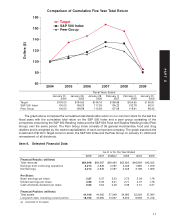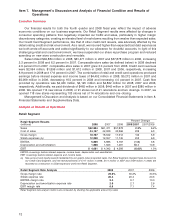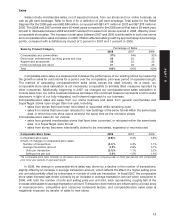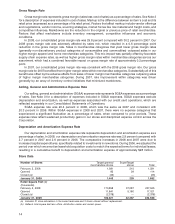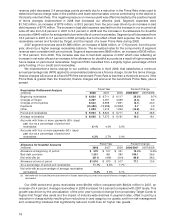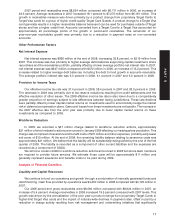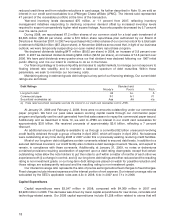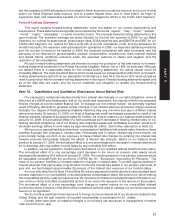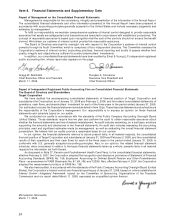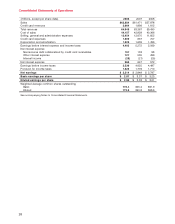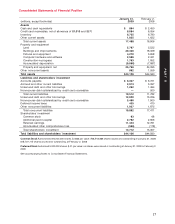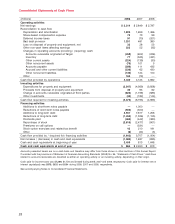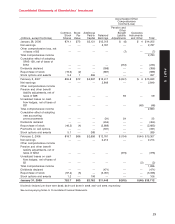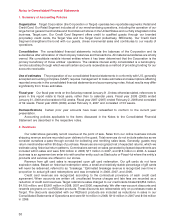Target 2008 Annual Report Download - page 41
Download and view the complete annual report
Please find page 41 of the 2008 Target annual report below. You can navigate through the pages in the report by either clicking on the pages listed below, or by using the keyword search tool below to find specific information within the annual report.
our ultimate cost based on an analysis of historical data and actuarial estimates. General liability and workers’
compensation liabilities are recorded at our estimate of their net present value; other liabilities referred to
above are not discounted. We believe that the amounts accrued are adequate, although actual losses may
differ from the amounts provided. We maintain stop-loss coverage to limit the exposure related to certain risks.
Refer to Item 7A for further disclosure of the market risks associated with our insurance policies.
Income taxes We pay income taxes based on the tax statutes, regulations and case law of the various
jurisdictions in which we operate. Significant judgment is required in determining income tax provisions and in
evaluating the ultimate resolution of tax matters in dispute with tax authorities. Historically, our assessments of
the ultimate resolution of tax issues have been materially accurate. The current open tax issues are not
dissimilar in size or substance from historical items. We believe the resolution of these matters will not have a
material impact on our consolidated financial statements. Income taxes are described further in Note 22.
Pension and postretirement health care accounting We fund and maintain a qualified defined benefit
pension plan. We also maintain several smaller nonqualified plans and a postretirement health care plan for
certain current and retired team members. The costs for these plans are determined based on actuarial
calculations using the assumptions described in the following paragraphs. Eligibility for, and the level of, these
benefits varies depending on team members’ full-time or part-time status, date of hire and/or length of service.
Our expected long-term rate of return on plan assets is determined by the portfolio composition, historical
long-term investment performance and current market conditions.
The discount rate used to determine benefit obligations is adjusted annually based on the interest rate for
long-term high-quality corporate bonds as of the measurement date using yields for maturities that are in line
with the duration of our pension liabilities. Historically, this same discount rate has also been used to
determine pension and postretirement health care expense for the following plan year. Effective February 4,
2007, we adopted the measurement date provisions of SFAS No. 158, ‘‘Employers’ Accounting for Defined
Benefit Pension and Other Postretirement Plans, an amendment of FASB Statements No. 87, 88, 106, and
132(R)’’ (SFAS 158). The discount rates used to determine benefit obligations and benefits expense are
included in Note 27. Benefits expense recorded during the year is partially dependent upon the discount rates
used, and a 0.1 percent increase to the weighted average discount rate used to determine pension and
postretirement health care expenses would decrease annual expense by approximately $4 million.
Based on our experience, we use a graduated compensation growth schedule that assumes higher
compensation growth for younger, shorter-service pension-eligible team members than it does for older,
longer-service pension-eligible team members.
Pension and postretirement health care benefits are further described in Note 27.
2008 Adoptions
In September 2006, the FASB issued SFAS No. 157, ‘‘Fair Value Measurement’’ (SFAS 157). SFAS 157
defines fair value, provides guidance for measuring fair value in accordance with GAAP and expands
disclosures about fair value measurements. SFAS 157, as originally issued, was effective for fiscal years
beginning after November 15, 2007. However, in February 2008, the FASB issued FASB Staff Position
FAS 157-2, which deferred the effective date of SFAS 157 for one year, as it relates to nonfinancial assets and
liabilities. We adopted SFAS 157 for financial assets and liabilities at the beginning of the first quarter of 2008,
and the adoption had no impact to our consolidated net earnings, cash flows and financial position.
Subsequent to our adoption of SFAS 157, the FASB has issued various other FASB Staff Positions and
guidance on fair value measurement; the additional guidance has not had an impact on our adoption. We will
adopt SFAS 157 for nonfinancial assets and liabilities at the beginning of 2009 and do not expect to have a
material impact on our consolidated net earnings, cash flows or financial position.
In February 2007, the FASB issued SFAS No. 159, ‘‘The Fair Value Option for Financial Assets and
Financial Liabilities’’ (SFAS 159). SFAS 159 permits entities to choose to measure many financial instruments
and certain other items at fair value. We adopted SFAS 159 at the beginning of fiscal 2008, and the adoption
had no impact to our consolidated net earnings, cash flows or financial position.
In March 2008, the FASB issued SFAS No. 161, ‘‘Disclosures about Derivative Instruments and Hedging
Activities, an amendment of FASB Statement No. 133’’ (SFAS 161). SFAS 161 requires enhanced disclosures
about derivatives and hedging activities. SFAS 161, as originally issued, was effective at the beginning of fiscal
21
PART II
New Accounting Pronouncements


